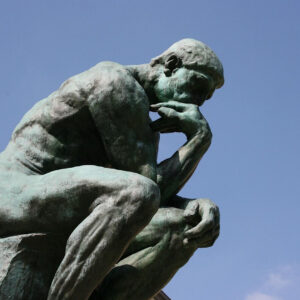A guy goes to a psychiatrist to help him deal with some emotional problems. The doctor shows the patient several Rorschach prints, splotches of ink with no discernible form, designed to help reveal the workings of a person’s mind. After being shown the first blot and asked what he sees, the man replies, “I see two people having sex.” After being shown the second print, the fellow again reports, “I see two people having sex.” He provides the same answer after being shown the next several ink-blots.
Finally, the psychiatrist asks, “Sir, doesn’t it seem odd that you keep seeing sexual encounters?”
Our friend responds, “What do you expect, Doc? You keep showing me erotic pictures.”
The first two principals on the yoga path are yama and niyama. These Sanskrit terms guide the aspirant to refrain from unethical behavior and engage in selfless behavior. When beginning yoga students first encounter these principals, they certainly seem like a good idea. After all, most people attracted to yoga already acknowledge that being an ethical person is an admirable and worthy goal.
The principals, however, point in a direction that most will find very challenging — the relinquishment of anger, greed, possessiveness, and lust. While many may claim to aspire for selflessness, it is my experience that most regular people will be able to do a headstand well before overcoming the deep-rooted patterns of anger and lust. The reason for this is that pursuing pleasure and objecting to pain is inherent in personal identity.
The person who attempts to change herself through discipline and will-power will not succeed. Because the problem, according to yoga, is not so much behavior, rather, it is identity and the nature of perception that arises from self-identity. The manner in which you behave is the result of who you believe yourself to be. Your self-identity will determine your perception and responses to the world. This is the crucial point.
Before I address this, let me be clear that some degree of moral discipline based on social agreements is worthwhile. For instance, no matter how strongly you desire to drive on the left side of the road, I strongly encourage you to discipline yourself from this impulse and remain on the right side. Of course, in Europe, one would drive on the left side, which is a good demonstration of the relative nature of social codes, but this would be a topic for another discussion.
Identity is a sense of self-based on a core feeling, which we call “I.” We link the “I” to all sorts of physical, emotional, psychological, and external objects. We then feel “I am… a man, a woman, of a certain age, who owns a used Subaru, with a life and problems, etc.” All authentic yoga practices are intended to inspire us to question this sense of self-identity. This process is known as atma-vichara, “the quest for the soul,” and it involves peeling off the layers of false self-identity. This may sound esoteric on first hearing, but it’s really as practical as peeling a banana skin to get to the fruit.
For the overwhelming majority of people, the sense of self, the identity of “I,” is based on a mistake. As an example, baby ducklings imprint on the mama duck when they are born. The babes then paddle behind the mother on the lake. There are cases, though, of baby ducklings seeing a zookeeper before their mother. The result is they imprint on the zookeeper and waddle behind him. Unenlightened human beings have also made a mistake by imprinting on pain and fear. The yogis provide us with the message that we can correct this mistake and, instead, imprint on the happiness and love in our own inherent divinity.
This feeling of “I,” exists on a level of consciousness prior to the arising of the cognitive mind. This is why the mind must be transcended in meditation if we hope to understand the yoga teachings. There is no solution to the problem of pain that can be found in the world of objects, relationships, or activities. The answer is revealed by accessing the level of consciousness underlying the mind. Here is the peace, love, and satisfaction for which we are all longing.
When we set about to correct negative behavior, our most common approach is similar to trying to stop a spinning fan. We believe if we are determined and strong enough, we can jab something into the fan so the blades can’t turn. Well and good, except besides the discomfort of sticking something in the fan, it also takes considerable energy to hold the object in place. An inevitable struggle occurs between the force of the fan and the effort required to prevent its course. Eventually, the struggle becomes overwhelming, one’s will-power becomes exhausted, and the fan spins again. In other words, there is a reversion to the existing pattern. This dynamic explains why New Year’s resolutions so rarely hold.
The yogic method of overcoming negative patterns of behavior is different. Yoga deals with the cause, not the effect. We trace the cause of the spinning fan to its root — the electric plug in the socket. Then, it’s a simple matter of unplugging the cord. The fan stops spinning and the problem is resolved. End of story. Well, not quite, because for most folks the slowing fan is so disconcerting that they plug that old cord right back into the wall! The disruption of familiar, painful dramas is initially upsetting. This unwillingness to “let go,” however, is not surprising and is no big deal. The answer has been found and, with repeated application, the individual will eventually feel safe enough to empower himself to pull that darn plug out once and for all.
People are not bad, sinful, or flawed beyond redemption. We are simply mistaken. We don’t know who we are or why we perceive the world the way we do, and why we act in ways that are harmful to ourselves and others. Until we understand, until we develop the wisdom that transcends the mind, our inner emptiness will drive us to pursue happiness through externals. Like our friend the psychiatric patient, we will see the world through distorted vision. Through yoga practice, however, we go beyond the fear, loneliness, and confusion of false identity. Problems naturally dissolve, and love and freedom spontaneously arise. Inkblots are then seen as nothing but ink, and the soul is seen as nothing but Divine.

The Myth of ‘The Thinker’
In our modern age, we often imagine we are too sophisticated to believe in myths. We scoff at the beliefs of previous eras, when supposedly



